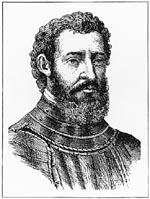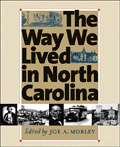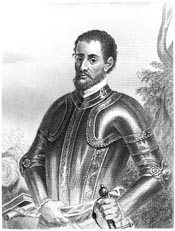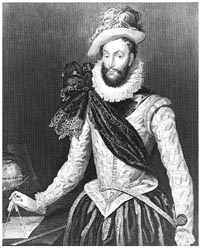
Giovanni da Verrazzano
|



LOST CONTINENT TO LOST COLONY . . .
CHAPTER EXCERPTS
 he first European explorers of North Carolina, like all early voyagers to the New World, did not find what they were actively seeking. Initially, they envisioned the discovery of an ocean pathway to the treasures of the East. It took Europeans almost a century to adjust their maps and their minds to the reality that they encountered on the Carolina coast: the sweet-scented edge of a massive continent. he first European explorers of North Carolina, like all early voyagers to the New World, did not find what they were actively seeking. Initially, they envisioned the discovery of an ocean pathway to the treasures of the East. It took Europeans almost a century to adjust their maps and their minds to the reality that they encountered on the Carolina coast: the sweet-scented edge of a massive continent.
The French hired their own skilled Italian navigator—Giovanni da Verrazzano—and commissioned him to explore unknown latitudes in the western Atlantic in search of a northerly route to China. In 1524 the hundred-ton ship La Dauphine sailed with a crew of fifty aboard, intending to reach China by sea. If blocked by "a barrier of new land," Verrazzano was to search for a "strait to penetrate to the Eastern Ocean."

Hernando de Soto
|
Looking for China, the explorer had encountered what would later be North Carolina. His initial landfall was somewhere along the coast north of Cape Fear in what is now New Hanover County. But, like Columbus, Verrazzano searched for signs that he had reached some outer tip of Asia. He reported that the inhabitants "resembled the Orientals, particularly those from the farthest Sinarian regions" and that the ground was of a color that suggested gold. He noted "palms, laurel, cypress and other varieties of tree unknown in our Europe" in the fragrant forests he and his men had smelled from a hundred leagues off shore. "We think that they belong to the Orient by virtue of the surroundings, and that they are not without some kind of narcotic or aromatic liquor."
Exactly how far north de Soto's expedition penetrated remains a mystery. Accepted judgments have put Xuala near the present-day intersection of the South Carolina, North Carolina, and Georgia borders, but some scholars now locate Xuala much farther north, between Marion and Old Fort in McDowell County.
Leaving Plymouth, England, on 27 April 1584, Captains Philip Armadas and Arthur Barlow reached the Outer Banks on 13 July and claimed the land for Queen Elizabeth. Unlike Verrazzano, they located an inlet through the cape and were able to drop anchor in the sound near an island that "the Indians call Roanoak." (The Elizabeth II, a replica of a sixteenth-century sailing vessel, can be seen today at Roanoke Island Festival Park.) After six weeks of exploration and trade, they returned to England with favorable reports and two Indians, Manteo and Wanchese, for Raleigh and Elizabeth. On 6 January 1585, when Raleigh was knighted by the Virgin Queen and given permission to call the land Virginia in her honor, plans were already under way for a permanent settlement.

Sir Walter Raleigh
|
It seems likely that at least some of the lost colony members did go south to live and intermarry with the native people on the Outer Banks. In the mid-seventeenth century, the Hatteras (or Croatan) Indians would migrate inland, like other small coastal groups at the same time. It is possible, though not certain, that members of the Lumbee tribe now living in the Lumberton area of Robeson County are descended in part from this Outer Banks contingent of Indians and English.
Some historians now believe that another contingent from Roanoke may have gone north to Chesapeake Bay, the colony's original destination, and settled among the Chesapeake Indians near Cape Henry in present-day Virginia. The Englishman William Strachey later claimed to have reports that Powhatan, chief of an Indian confederation, advised by his counselors to destroy the Chesapeakes and the English living with them, had done so in 1607, at just the time that the Jamestown colonists arrived. The king of England had been informed, Strachey wrote, that Powhatan had "miserably slaughtered" the "men, women, and children of the first plantation at Roanoak . . . (who 20. and od yeeres had peacably lyved and intermixed with thos Savadges, and were out of his Territory)." The Jamestown colonists were specifically instructed to look for survivors from the lost colony, and two men sent to Roanoke Island in 1608 brought back crosses and letters of English origin, but no other news.
|

